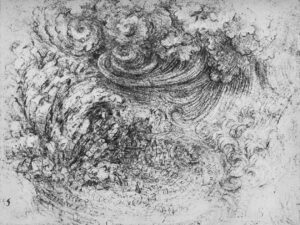According to Prof. Martin Kemp, in a talk he gave at EPFL in 2011, if Leonardo da Vinci looked at ripples of water, long wavy hair or wispy clouds, he always saw the same thing - patterns. To a Renaissance man these patterns were simply different manifestations of similar phenomena. According to one author, Leonardo even used such patterns to predict the weather.
In many fields of modern science, researchers have returned to this mode of thinking. For example, when Prof. Olga Fink looks at railway networks, power supply systems, and even the human brain, what fascinates her most is what they have in common: they can be represented as nodes, arranged in vast networks, that interact with each other. These interdependencies: how they interact, how one can model their dynamic behaviour, are at the beating heart of the Laboratory of Intelligent Maintenance and Operations Systems (IMOS) - and they, too, allow for predictions of the future.
Prof. Fink’s research addresses a broad spectrum of applications, from hydropower plants and the rolling bearings of large-scale wind turbines, to ensuring the reliability of aircraft engines. Her work combines engineering and computing technologies that can predict a system's changing condition over time, and to anticipate potential future maintenance issues.
"Machine learning is undeniably powerful at processing data," explains Prof. Fink, "but it struggles with applying learned algorithms to previously unseen operational regimes, or to different environmental conditions. We develop algorithms with two key capabilities: first, we incorporate the laws of physics, enabling them to generalize better, and become more interpretable - both crucial, for real world scenarios. Secondly, we make sure they are robust in the face of changing operating and environmental conditions, such as fluctuations in temperature and load, by integrating the operating condition context into the process of extracting node dynamics.

"And sensor networks can be extremely complex. They often produce vast amounts of different types of data. Networks will often change structure under different circumstances, and all those sensors might produce data with completely different patterns. What is more, a range of environmental and operating conditions can further influence the captured or measured data."
This kind of research is inherently multidisciplinary. "We have researchers with many different skill sets. Although most have an engineering background, with an understanding of computing, some are the opposite. It is sometimes difficult to convince computing experts to dive into the world of physics, but that is our mission.
"We also have a neuroscientist in our team. There are many parallels between our work and neuroscience. For us, networks of sensors have a lot of similarities to nodes and synapses."
The research of IMOS benefits from collaborations with industry, which ensure that their research addresses real-world problems, and that their developed approaches are tested on real data. For research into renewable energy hardware, such as hydropower plants, they collaborate with SBB Energy. There have also been collaborations with NASA, on remaining useful lifetime prediction.
The recent Intelligent Maintenance Conference featured talks from representatives of SBB Energy, Airbus, SNCF and Alstom.
Such is the multifaceted research of the Laboratory of Intelligent Maintenance and Operations Systems. Prof. Fink recalls an industrial partner once making the point that the problems her algorithms were predicting were issues that would only become relevant for the industry more than ten years into the future:
"I took it as a compliment. That is exactly what we are aiming for - preparing, getting ready for the future."
Photo: Alain Herzog
Text: John Maxwell